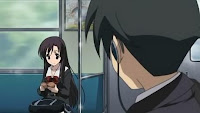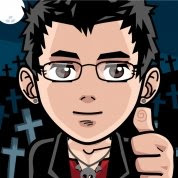 "School Days" is a gripping, slice-of-life anime that tackles the darker aspects of high school life normally not portrayed in Anime. The story revolves around Makoto Itou, a freshmen student at Sakakino Academy, who is in love with Kotonoha Katsura— a girl in the same year as he is and travels the same train he rides on. Watching from a distance, he only gains the courage to talk to Katsura through the help of Sekai Saionji— a female classmate of Makoto's, who unknown to him, is secretly in love with him.
"School Days" is a gripping, slice-of-life anime that tackles the darker aspects of high school life normally not portrayed in Anime. The story revolves around Makoto Itou, a freshmen student at Sakakino Academy, who is in love with Kotonoha Katsura— a girl in the same year as he is and travels the same train he rides on. Watching from a distance, he only gains the courage to talk to Katsura through the help of Sekai Saionji— a female classmate of Makoto's, who unknown to him, is secretly in love with him.You would think upon first glance, this would be the typical best-friend-in-love-with-friend-who-is-in-love-with-another-girl love triangle. Makoto does fall for Sekai as well, but this is not in the bitter sweet confusion of love. Even before Makoto's and Kotonoha's relationship could even deepen into a real rel
 ationship. Makoto's feelings begin to slip as he starts to complain of how tiring it is to be with Katsura and not as fun as he thought it would be to have a girlfriend. His attention turns to Saionji, whose offer of 'practice' with her turns carnal. Instead of escorting Katsura home from a group date at a indoor swimming park, Makoto leaves Katsura at the station and goes to Saionji's place. Makoto sleeps with Saionji.
ationship. Makoto's feelings begin to slip as he starts to complain of how tiring it is to be with Katsura and not as fun as he thought it would be to have a girlfriend. His attention turns to Saionji, whose offer of 'practice' with her turns carnal. Instead of escorting Katsura home from a group date at a indoor swimming park, Makoto leaves Katsura at the station and goes to Saionji's place. Makoto sleeps with Saionji. Now in a relationship with Makoto, Sekai guilt-ridden cause of her betrayal of trust with Katsura, tries to convince Makoto that they should tell Kotonoha of their relationship. But Makoto unwilling to face Kotonoha, tells Sekai that they should wait for a better time to do so. Which only worsens the situation, Sekai's friends— Setsuna Kiyoura, Hikari Kuroda, and Nanami— convinced of their relationship, begin to despise Katsura; seeing her as desperate woman trying to steal away their bestfriend's boyfriend. Katsura gets further abuse in her own classroom, as Otome Kato— a former schoolmate of Makoto in middle school who is secrelty in love with him— and her gang bully Kotonoha into doing additional work for the school's cultural festival.
Now in a relationship with Makoto, Sekai guilt-ridden cause of her betrayal of trust with Katsura, tries to convince Makoto that they should tell Kotonoha of their relationship. But Makoto unwilling to face Kotonoha, tells Sekai that they should wait for a better time to do so. Which only worsens the situation, Sekai's friends— Setsuna Kiyoura, Hikari Kuroda, and Nanami— convinced of their relationship, begin to despise Katsura; seeing her as desperate woman trying to steal away their bestfriend's boyfriend. Katsura gets further abuse in her own classroom, as Otome Kato— a former schoolmate of Makoto in middle school who is secrelty in love with him— and her gang bully Kotonoha into doing additional work for the school's cultural festival.A far dry from the usual genre of romantic comedy animes based a dating sim game or H-game. Wherein one guy is surrounded by a multitude of doleful-eyed, sweet, and kawaii girls and can’t make up his mind who is the girl of his dreams. “School Days” instead tackles the darker aspects of high school life such as bullying, date rape, and pregnancy. Highly sensitive topics considered taboo in mainstream anime.
Makoto from the sweet, sincere yet hesitant guy, who you would think at first
 glance appreciate the deeper sentiments of love, turns the complete opposite. Like the average teenage guy those idea of having a relationship with a girl is having his way with her; in-experience with the deeper aspects of having a relationship. You would get irritated by Makoto’s naïve and ignorant idea of a relationship. But as you go on watching the anime, this irritation slowly turns into loathing and disgust, as Makoto ignorant and impatient with the current pace of his relationship with Katsura, turns his attention to Saionji, those offer of ‘practice’ leads him away from Kotonoha.Trading the deep, sincere, and sweet love of Katsura for Saionji’s blind willingness to have his way with her.
glance appreciate the deeper sentiments of love, turns the complete opposite. Like the average teenage guy those idea of having a relationship with a girl is having his way with her; in-experience with the deeper aspects of having a relationship. You would get irritated by Makoto’s naïve and ignorant idea of a relationship. But as you go on watching the anime, this irritation slowly turns into loathing and disgust, as Makoto ignorant and impatient with the current pace of his relationship with Katsura, turns his attention to Saionji, those offer of ‘practice’ leads him away from Kotonoha.Trading the deep, sincere, and sweet love of Katsura for Saionji’s blind willingness to have his way with her. 
In someway, you will both hate and pity Sekai, in her blind love for Makoto have his way with her, because she loves him. Kotonoha, on the other hand, aware of Makoto’s infidelities, turns a blind eye, keeping faith in him despite of it all. Beautiful, kind, sincere, and loving, you can only feel sorrow for her as she sinks into madness.












